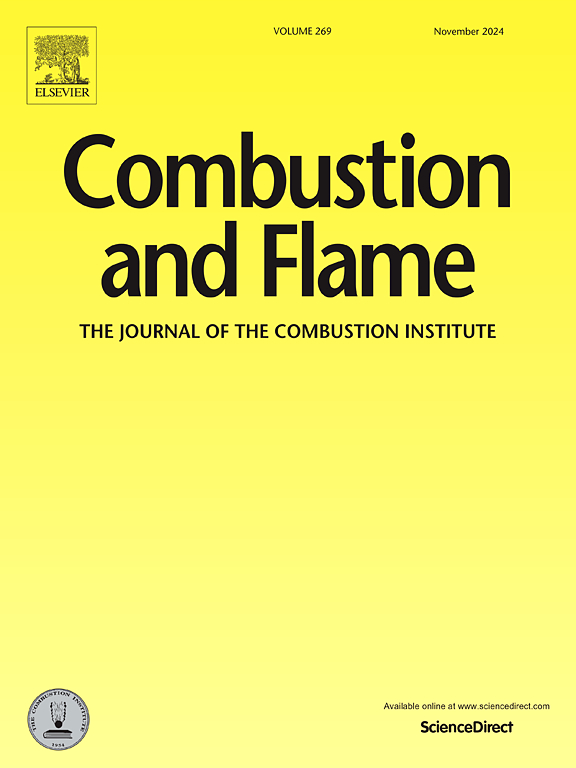N-containing pollutant formation in pyrrole counterflow diffusion flames
IF 5.8
2区 工程技术
Q2 ENERGY & FUELS
引用次数: 0
Abstract
Biomass conversion through direct combustion (energy production) or pyrolysis (bio-oil production) are novel concepts to reduce CO2 emission in the energy sector. However, the nitrogen content in biomass feedstocks may result in elevated N-containing pollutants, e.g., NOx, NH3, HCN, and nitriles, yet their formation chemistry remains unclear. In this work, we studied N-containing pollutant formation in counterflow diffusion flames fuelled by pyrrole, a biomass tar surrogate component that accounts for the majority of fuel nitrogen. 27 species, including 8 N-containing species, were identified and measured in three flames with designed boundary conditions to reveal the influence of flame temperature and methane addition. Species mole fraction comparisons showed that methane addition and higher flame temperature promoted C2–C6 hydrocarbon formation, but mole fractions of N-containing species did not change much, reflecting less dependence on flame temperature or hydrocarbons in the species pool. An existing kinetic model for pyrrole pyrolysis and combustion was developed by updating the formation reactions of N-containing species based on recent literature studies. Numerical simulations using the kinetic model well reproduced mole fractions of most species except for NO and NO2. Model analyses illustrated the nitrogen conversion pathways from pyrrole to individual N-containing pollutant species, and indicated the possible reactions for underestimated mole fractions of NO and NO2. This work contributes to a better understanding of the combustion properties of N-containing fuels and N-containing pollutants in the context of biomass energy clean utilization.
吡咯逆流扩散火焰中含氮污染物的形成
通过直接燃烧(能源生产)或热解(生物油生产)的生物质转化是能源部门减少二氧化碳排放的新概念。然而,生物质原料中的氮含量可能导致含氮污染物(如NOx、NH3、HCN和腈)升高,但其形成化学尚不清楚。在这项工作中,我们研究了以吡咯为燃料的逆流扩散火焰中含氮污染物的形成,吡咯是一种生物质焦油替代成分,占燃料氮的大部分。在设计的边界条件下,对3种火焰中27种含氮物质进行了鉴定和测量,揭示了火焰温度和甲烷添加量的影响。物种摩尔分数比较表明,甲烷的加入和较高的火焰温度促进了C2-C6烃的形成,但含n物种的摩尔分数变化不大,反映了对火焰温度或物种池中碳氢化合物的依赖性较小。在文献基础上,对含n物质的生成反应进行了更新,建立了现有的吡咯热解燃烧动力学模型。利用动力学模型进行的数值模拟较好地再现了除NO和NO2外大多数物种的摩尔分数。模型分析说明了氮从吡咯转化为单个含氮污染物的途径,并指出了被低估的NO和NO2摩尔分数可能发生的反应。这项工作有助于更好地了解生物质能清洁利用背景下含氮燃料和含氮污染物的燃烧特性。
本文章由计算机程序翻译,如有差异,请以英文原文为准。
求助全文
约1分钟内获得全文
求助全文
来源期刊

Combustion and Flame
工程技术-工程:化工
CiteScore
9.50
自引率
20.50%
发文量
631
审稿时长
3.8 months
期刊介绍:
The mission of the journal is to publish high quality work from experimental, theoretical, and computational investigations on the fundamentals of combustion phenomena and closely allied matters. While submissions in all pertinent areas are welcomed, past and recent focus of the journal has been on:
Development and validation of reaction kinetics, reduction of reaction mechanisms and modeling of combustion systems, including:
Conventional, alternative and surrogate fuels;
Pollutants;
Particulate and aerosol formation and abatement;
Heterogeneous processes.
Experimental, theoretical, and computational studies of laminar and turbulent combustion phenomena, including:
Premixed and non-premixed flames;
Ignition and extinction phenomena;
Flame propagation;
Flame structure;
Instabilities and swirl;
Flame spread;
Multi-phase reactants.
Advances in diagnostic and computational methods in combustion, including:
Measurement and simulation of scalar and vector properties;
Novel techniques;
State-of-the art applications.
Fundamental investigations of combustion technologies and systems, including:
Internal combustion engines;
Gas turbines;
Small- and large-scale stationary combustion and power generation;
Catalytic combustion;
Combustion synthesis;
Combustion under extreme conditions;
New concepts.
 求助内容:
求助内容: 应助结果提醒方式:
应助结果提醒方式:


